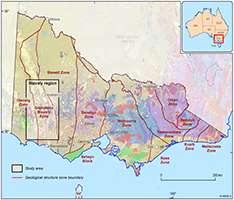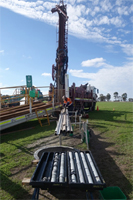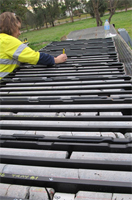News
Uncovering the mineral systems potential of the Stavely Region, western Victoria
Published:27 November 2014
Uncovering the mineral systems potential of the Stavely Region, western Victoria
Anthony Schofield and Narelle Neumann
A collaborative minerals project being undertaken in the Stavely region of western Victoria is helping to reduce exploration risk for explorers by improving understanding of the subsurface geology and its potential for mineral systems.
This project forms part of the broader UNCOVER initiative, which seeks to address the challenges of 'greenfield' exploration in under-cover areas in Australia through the provision of pre-competitive fundamental geoscience data and concepts. There are particular technical challenges associated with greenfield exploration, mainly related to the greater depths that may be necessary to explore in order to make discoveries.
The Stavely region
The regional geology and drilling program in the prospective Stavely region of western Victoria is being undertaken by Geoscience Australia in partnership with the Geological Survey of Victoria and the Deep Exploration Technologies Cooperative Research Centre (DET CRC). Understanding the geological structure and evolution of this region is a key step in providing the knowledge needed to assess the mineral potential and thus its attractiveness for further exploration investment. It is through the provision of this pre-competitive data and knowledge that future mineral discoveries will occur.

Geological map of Victoria showing the
structural geological zones of Victoria,
highlighting the Stavely region.
Adapted from Geological Survey of Victoria.
Several belts of prospective Cambrian igneous rocks occur within the Stavely region. Similar geological environments throughout the world host economically important mineral deposits that are a source of copper, gold, and other metals. Although these rocks are largely obscured by recent sediments and other cover, geophysical data show that they continue beneath this veneer. A number of known historical prospects are associated with the volcanic belts, several of which are currently being actively explored. Given the geological setting of the Stavely region, there is great potential for economic mineral systems to be buried beneath relatively shallow cover rocks.
In order to more fully assess the Stavely region's potential, there is a requirement for obtaining new stratigraphic drill core samples to test the geological models and to assess, through detailed analysis of these samples, whether a mineral system is present or likely.
Drilling in the Stavely region
In order to test these geological models, 14 fully-cored stratigraphic holes were drilled as part of the project. Estimates of the depths to prospective geology were determined prior to drilling using a range of geophysical techniques. These helped to plan drilling operations and assist with drill-hole location selection. A report detailing the techniques used and their application for determining depth to basement will be publically released in 2015. In total, over 2700 metres of fully cored holes were drilled, using both sonic and diamond drilling techniques.
Where basement rocks were found to be covered by recent material, sonic drilling was used to penetrate to basement before completing the holes with 'tails' drilled using conventional diamond drill rigs. The use of sonic drilling has enabled near 100 per cent recovery of the unconsolidated cover materials. This is not usually possible using conventional drilling rigs, which can lose a large percentage of the drill core when drilling poorly-consolidated loose sediments. These new sonic cores provide some of the most complete stratigraphic drill hole records for the Murray Basin. These cores will be invaluable for further cover-based studies and for the analysis of 'distal footprint signatures' of buried basement-hosted mineralisation. The deepest sonic hole penetrated to a depth of 212 metres, marking the deepest hole drilled using this method in Australia to date.
Diamond drilling took place at 13 of the holes in order to obtain necessary basement material for detailed analysis. In a number of places, diamond drilling intersected Cambrian igneous rocks favourable for hosting mineral systems. Many cores showed evidence of hydrothermal alteration, which is consistent with a mineral system. During diamond drilling, near real-time geochemical analyses were undertaken with the assistance of Lab-at-Rig™ technologies deployed by the DET CRC. This allowed for rapid rock characterisation and identification of anomalous element concentrations.
Building an understanding of the Stavely region
Following the completion of drilling, a comprehensive range of investigations are planned to be undertaken on samples recovered in drill core. The drill core has been scanned using HyLogger™ technology which use reflectance spectroscopy to determine the mineral composition of the drill core samples. A collection of rock property measurements are currently being acquired using the AuScope Australian Geophysical Observing System facility at the University of Melbourne. Following these non-destructive analytical methods, the core will then be split and further sampled for a range of chemical and isotopic analyses.
Additional data collection at drill sites, including down-hole geophysical logging and geothermal measurements, is due to be undertaken in late 2014. The results of these analyses will help geoscientists to better understand the rocks present and how they fit in with proposed geological models of the region and the mineral systems potential of the Stavely region.
Results of these investigations are due to be released as fundamental datasets in 2015. An explorer's guide to the Stavely region will follow, which will outline the subsurface geology, provide evidence for the presence of mineral systems, and highlight the concepts that inform on further targeting of mineralisation within the most prospective corridors.
Further information
Contact:
Phone:
Email:






